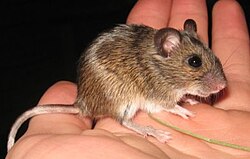| Ural field mouse | |
|---|---|
 | |
| Scientific classification | |
| Kingdom: | Animalia |
| Phylum: | Chordata |
| Class: | Mammalia |
| Order: | Rodentia |
| Family: | Muridae |
| Genus: | Apodemus |
| Species: | A. uralensis |
| Binomial name | |
| Apodemus uralensis (Pallas, 1811) | |
 | |
| Range of A. uralensis Resident | |
| Synonyms [2] [3] | |
| |
The Ural field mouse (Apodemus uralensis) is a species of rodent in the family Muridae. It is also known as the pygmy field mouse. It is found in Armenia, Austria, Azerbaijan, Belarus, Bulgaria, China, Croatia, Czech Republic, Estonia, Georgia, Hungary, Kazakhstan, Latvia, Liechtenstein, Lithuania, Mongolia, Montenegro, Poland, Romania, Russian Federation, Serbia, Slovakia, Turkey and Ukraine.
